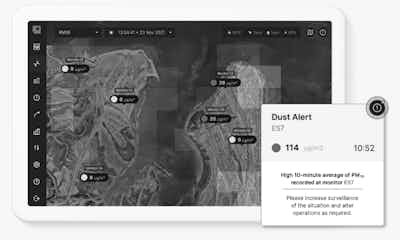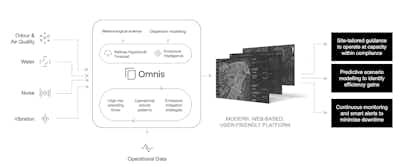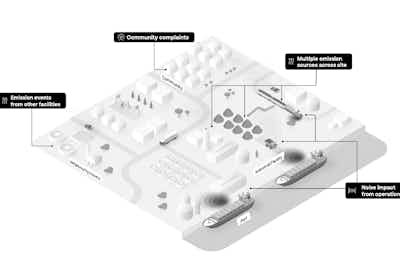To begin with, let’s explore why air quality alerts are implemented in the first place.
Industrial facilities play a critical role in the economy as they provide products and services for various sectors. However, the production processes in these facilities can release harmful pollutants to the environment, which threaten air quality and public health.
Maintaining air quality compliance conditions in industrial facilities is essential to protect the environment and public health, but also to avoid significant regulatory fines.
So, how do operators know when emissions breaches are problematic and when they can top up their coffee?
The devil is in the detail: Grasping what licence conditions specifically stipulate for air quality management
It’s highly important for facility teams to familiarise themselves with the fine print in in their operating licence conditions. This sounds obvious, but regulations include detailed outlines of pollutants that facilities can release into the atmosphere and threshold limits for each of them.
Air quality compliance typically focusses on air quality monitoring data, maintaining records and reporting emissions data based on pollutants outlined. However, this information can provide powerful insights to create alerts for operational guidance to incorporate air quality compliance efforts while also minimising costly downtime period.
A comprehensive understanding of specific weather data and its influence on pollutants can be combined with licence conditions to tailor alerts specific to facility requirements. After deployment and initial refinement, these alerts will begin to provide precise operational decision support, while also allowing facilities to ignore what doesn’t matter.

Often Industrial operators experience alert fatigue due to too many data siloes created from monitoring an increasing number of risks across their sites.
Cut through the noise: Are they actually ‘smart alerts” or just another alarm?
Real ‘smart’ alerts, rather than alerts triggered by a single threshold number, can be tailored to reduce alert fatigue by providing far more detailed context to support emissions mitigation activities.
Alerts using sensor data from across the facility can be used to detect air quality issues that could lead to compliance violations. This includes analysis of pollutant detection emitted from industrial processes, and operators receive alerts when the pollutant levels exceed the regulatory limits.
The ability to configure smart air quality alerting systems with descriptive prompts on recommended actions can help deliver an early warning of events and easy analysis of past events. This can help operators manage and report on the information required by regulators and the community, but also allow non subject matter experts to mitigate emissions risks effectively.
For instance, the right alerts can remind operators when they need to be concerned about lack of dust mitigation resources due to dry weather conditions, or when to conduct maintenance activities at times of low odour impact risks. Operators can ultimately prevent noncompliance and save facilities from hefty penalties and reputational damage.

Validate and Improve: Integrate real-time and predictive smart alerting directly into operational risk management plans
Integrating smart alerting systems into industrial facilities requires careful planning and a comprehensive approach. First, operators must choose the right system that meets their needs, depending on their type of business, the pollutants they emit, and the required regulatory standards. Second, they must ensure that the system is compatible with other equipment in their facility.
The right monitoring network in place can enable smart air quality alerting systems to be applied to any parameter on any monitor. This can be windspeed, PM10 or H2S for example. These alerts can provide value within specific windows of time of time when monitoring an area closely for a defined period.
Additionally, they can also be used to inform risk management plans such as Triggered Action Response Plans (TARP) or Odour Management Plants (OMP) that facilitate operational control actions based on the real-time monitoring network. Validation through operational improvements can constantly update and refine these plans in parallel with continuous updates of alerts to enhance accuracy.
Partner with the right providers that stay ahead of changes in air quality compliance
Static compliance data and paper-based reports don’t provide the situational awareness required to deploy effective emissions control strategies or respond to breaches. It’s difficult for operators to know the impact certain weather conditions will have on operational activities and when they need to plan for high-risk periods.
To make matters more challenging, air quality regulations will continue to evolve, and facilities must keep up with these changes to maintain compliance. The good news is that smart alerting systems will also continue to evolve with demands for businesses that want to remain competitive, meet regulatory standards, and operate sustainably.
The use of artificial intelligence, machine learning, and geospatial analysis in these systems will continue to enhance their effectiveness and accuracy.
Unlock value beyond compliance with digital air quality management solutions
As environmental regulations continue to evolve, industrial operators must keep up with these changes to avoid fines and reputational damage. By adopting smart alerting systems, industrial facilities can not only maintain compliance but also improve the quality of their products and services, reduce operating costs, and enhance safety for employees and the public.

Envirosuite Omnis solution assist operators from a growing number of operations around the world with air quality management, mitigating emissions impact and daily management of complex infrastructure.
Smart air quality alerts in Omnis can help your facility:
Identify problematic emissions sources to maintain compliance and reduce cost of mitigation.
Increase operational efficiency and minimise lengthy stoppages from breaches or non-compliance events.
Respond to community concerns about environmental impact and build social license to operate.

Get in touch with us today to find more.
